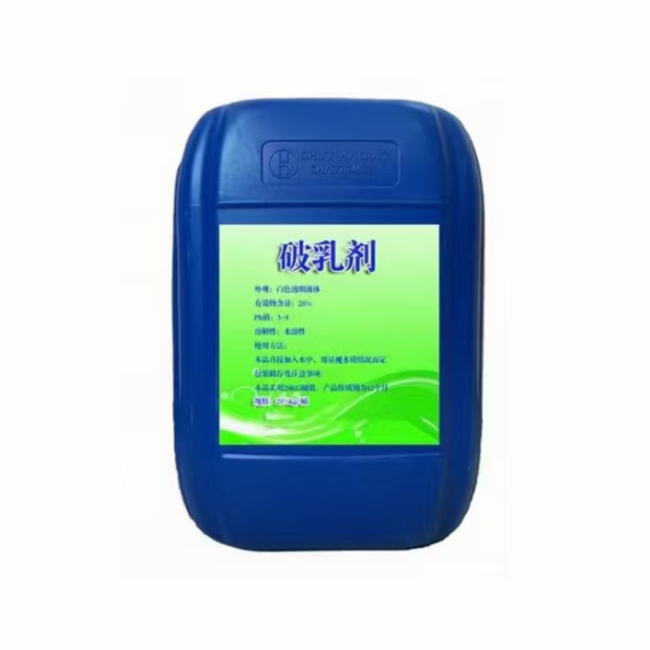

Demulsifier
Demulsifiers are nonionic surfactants used for water separation in coal washing plants and wastewater treatment facilities to meet moisture content standards. In oil wells, they reduce crude oil viscosity to prevent clogging. When mixed with water or other liquids containing insoluble solids, demulsifiers enable these substances to form emulsions through hydrodynamic or mechanical agitation, creating a stable suspension. These surfactants are categorized into two main types: water-soluble demulsifiers and oil-soluble demulsifiers.
- Product Description
Product Description
Demulsifiers are nonionic surfactants used for water separation in coal washing plants and wastewater treatment facilities to meet moisture content standards. In oil wells, they reduce crude oil viscosity to prevent clogging. When mixed with water or other liquids containing insoluble solids, demulsifiers enable these substances to form emulsions through hydrodynamic or mechanical agitation, creating a stable suspension. These surfactants are categorized into two main types: water-soluble demulsifiers and oil-soluble demulsifiers.
Breakdown agent product features:
1. Emulsifier is a surfactant that breaks the liquid structure of emulsions, enabling phase separation.
2. Crude oil demulsifiers separate oil and water in oil-water mixtures to achieve effective demulsification, ensuring water content standards for crude oil transportation.
3.Demulsifiers effectively separate organic and aqueous phases by disrupting interfacial membranes, meeting separation requirements.
4.Different demulsifiers demonstrate varying effectiveness, with their performance directly impacting phase separation efficiency. The extraction of penicillin also requires the use of emulsifying agents.
5.There are many kinds of demulsifiers. If classified according to the classification method of surfactants, they can be divided into: cationic, anionic, nonionic and two ionic demulsifiers.
(1) Anionic demulsifiers, when dissolved in water, generate negatively charged hydrophilic groups. These are classified into four categories based on their hydrophilic groups: carboxylates, sulfonates, sulfosuccinates, and phosphosuccinates. Common examples include carboxylate salts, sulfonate salts, and polyoxyethylene fatty sulfonate salts. However, these anionic demulsifiers have several drawbacks, such as requiring large quantities, demonstrating limited effectiveness, and being prone to performance degradation when exposed to electrolytes.
(2) The hydrophilic groups generated by the dissolution of cationic demulsifier in water are positively charged particle clusters,The hydrophilic group is mainly alkaline nitrogen atoms, but also phosphorus, sulfur, iodine and so on. The cationic demulsifier is mainly quaternary ammonium salt, which has obvious effect on general crude oil, but it is not suitable for heavy oil and aging oil.
(3) Nonionic demulsifiers remain ionically stable when dissolved in water, thus remaining electrically neutral. The main categories include: amine-initiated block polyether, alcohol-initiated block polyether, alkylphenolic resin-based block polyether, phenolic resin-based block polyether, silicon-containing demulsifiers, ultra-high molecular weight demulsifiers, polyphosphoric acid ester, modified block polyether products, and zwitterionic demulsifiers such as imidazoline crude oil demulsifiers.
(4) The two types of demulsifier can generate positive and negative ions after being dissolved in water. It is cationic in acidic solution and anionic in alkaline solution. The basic principles for selecting demulsifier are as follows:
(1) Emulsifiers possess strong surface activity that enables them to displace the emulsifier from the liquid-gas interface. All emulsifiers exhibit surface activity, as without it they cannot form an adsorption film at the interface—a spontaneous process. Consequently, demulsifiers must also demonstrate potent interfacial adsorption capabilities to effectively displace the emulsifier.
(2) The interface film formed by demulsifier on the oil-water interface should not have firmness, and it is easy to break under the action of external conditions or droplet collision, so the droplets are prone to agglomeration.
(3) Ionic emulsifiers can make the droplets charged and stable, and the use of ionic demulsifier with opposite charges can neutralize the surface charge of the droplets.
(4) Nonionic or polymer demulsifiers with large relative molecular mass dissolved in the continuous phase can cause droplet aggregation due to bridging, and then coalescence, stratification and demulsification.
(5) In solid powder emulsifiers, stable emulsions can utilize solid powders with excellent wettability as demulsifiers to ensure complete powder wetting into either the aqueous or oil phase. These principles indicate that demulsifiers and emulsifiers often lack clear boundaries and should be selected based on specific system requirements. Notably, some surfactants are exclusively suitable as demulsifiers for specific emulsions and cannot function as either demulsifiers or emulsifiers in other systems.
Matters Need Attention :
The demulsifier will change with the change of temperature. When the temperature is lower than a certain value, the demulsifier will turn white, or even thick and solidify. With the increase of temperature, the demulsifier will restore to become transparent, and the recovery will not affect the use effect of the demulsifier.

We'd love to hear from you.
Please leave a message, we will get in touch with you as soon as possible!











 Home
Home






